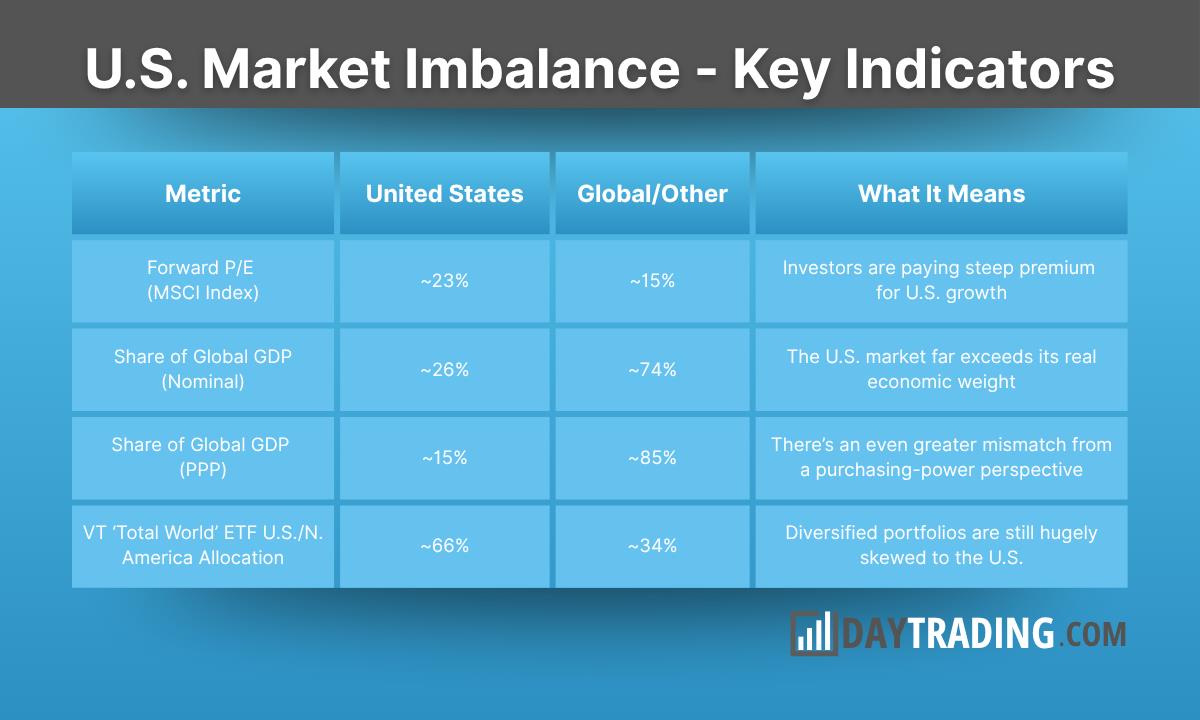
Daytrading's Head Analyst Issues Warning That US Stock Market Is Priced For Impossible Perfection
Analysis from an investor with 60,000+ hours trading under his belt and a degree in Economics from Harvard examines the current valuation landscape of U.S. equities..
DayTrading.com 's Dan Buckley started by looking at basic metrics, namely the forward Price-to-Earnings (P/E) ratio. This evaluates how much today's investors are paying for each dollar of next year's expected profit.
The U.S. market is trading at roughly 23x forward earnings, which is far above the 15x times level seen in international markets.
The last times the U.S. hit these sorts of valuations were:
-
2020–21 in the technology surge of the pandemic
2001–02 in the height of the dot-com bubble
Buckley noted that since the 2021 peak, the U.S. stock market has delivered a compound annual return of around 9%, but before that, it went nearly a decade without making substantial, sustained gains.
After the downturn in early 2022, U.S. equities took nearly two years just to get back to previous highs.
A Market Bigger Than Its Economy
Analysis from reviewed several metrics highlighting a familiar pattern: global investors maintain a significant weighting in U.S. assets compared with the scale of the underlying economy.
This imbalance reflects how influential U.S. markets have become within global portfolios and index benchmarks.
U.S. Market Imbalance
The research highlighted that the U.S. currently represents around 65% of the MSCI All Country World Index. This is a benchmark that guides billions in global investment flows.
Yet by comparison, America produces only around 26% of the world's economic output in nominal dollar terms, and it's actually more like 15% when adjusted for the cost of living.
Buckley noted that even investment vehicles labelled as“global” reflect this outsized concentration. For example, Vanguard's Total World Stock ETF (VT), is often used as a diversified core holding by many institutions. That still invests around 66% of its assets in the U.S., with 4% just in Nvidia.
The Outsized Impact Of AI
research took aim at AI, pointing out that roughly half of the S&P 500's gains in 2025 stem from companies tied to artificial intelligence – semiconductor leaders, mega-cap platforms, and infrastructure providers. These include now household names like Nvidia (NVDA), Microsoft (MSFT), Advanced Micro Devices (AMD), and Palantir (PLTR).Buckley observed that AI has become a major focus for both markets and corporate strategy, but noted that the extent and pace of its long-term impact remain to be seen.
Market Perspective: A Measured View
Buckley emphasized that his comments should not be interpreted as forecasting a market downturn. Rather, he offered a measured assessment of current U.S. equity conditions, noting potential areas of imbalance that may emerge when market expectations are elevated.
While financial markets can often behave unpredictably, Buckley observed that not all sectors appear overextended. Certain segments-including financials, healthcare, select industrials, and international markets-continue to show valuations that align more closely with underlying fundamentals.
The full analysis is available here: U.S. Stocks: Great Expectations, Even Greater Valuations
About
DayTrading.com is a platform that provides information and market analysis for individual investors. It's been used by millions of traders worldwide.
Tags: Crypto, Finance, Indices, SPY, Stocks Legal Disclaimer:
MENAFN provides the
information “as is” without warranty of any kind. We do not accept
any responsibility or liability for the accuracy, content, images,
videos, licenses, completeness, legality, or reliability of the information
contained in this article. If you have any complaints or copyright
issues related to this article, kindly contact the provider above.

















Comments
No comment